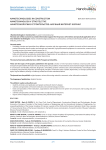Статьи журнала - Nanotechnologies in Construction: A Scientific Internet-Journal
Все статьи: 409
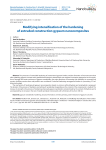
Modifying intensification of the hardening of extruded construction gypsum nanocomposites
Статья научная
The processes of controlled hardening of nanomineral gypsum binders and the formation of microstructure that allow obtaining gypsum concrete with specified technological characteristics are analyzed. Innovative approaches to the regulation of strength and water resistance of gypsum nanobinders, the main directions of increasing their durability in concretes and mortars, building constructions and products are considered. Controlled hardening nanogypsum binders is a promising 3-D additive technology. The mechanism of hardening of gypsum nanocomposites based on calcium sulfate dihydrate and semihydrate is proposed. The kinetics of the process of hydration and setting of nanobinders depending on the content of the components is studied. The increase in strength in the process of hardening of pressed gypsum nanobinders is determined by the content of dihydrate and is accompanied by an increase in the size of needle and plate microcrystals with a thickness of less than 100 nm.
Бесплатно
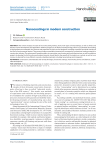
Nanocoatings in modern construction
Статья научная
The review analyzes the state of the nanocoating market, shows main types of nanocoatings, as well as drivers and barriers to their development and application. Modern progress in the field of nanotechnology allows us to attribute nanocoating to high performance materials, the structure and properties of which can be “designed” according to specific functional criteria and the level of environmental impact. They present unique remarkable characteristics compared to conventional coating materials in construction industry. The government’s grandiose plans to commission new housing and road infrastructure, as well as ambitious projects to develop the Arctic and ensure national security, should lead to the growth of the industry as a whole, as well as to an increase in demand for more efficient, innovative building materials, including nanocoatings and nanopaints.
Бесплатно
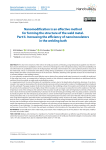
Статья научная
The short-term existence of the melt in the weld pool and its overheating, a large temperature gradient near the interface and two-dimensional crystallization centers, in the form of fused grains at the weld pool boundary, reduce the probability and rate of formation of crystallization centers in the liquid phase. This leads to the formation of a coarse-grained columnar structure of the weld metal, which, in combination with defects arising during crystallization, is less ductile than the fine-grained rolled metal being welded, and often causes brittle fracture of the structure. Therefore, obtaining a fine-grained structure of the weld metal is a constant problem in the welding industry. It is now generally accepted that the most effective way to obtain a fine-grained weld metal structure is to modify the weld pool. At the same time, micro- or nanoparticles of refractory metals or their chemical compounds (inoculators) are introduced into the weld pool from the outside, as ready-made crystallization centers. In a superheated melt, the rate of formation of crystallization centers, due to the deactivation of particles, decreases. It can be increased in two ways: by slowing down the decontamination process and by increasing the number of modifying particles introduced into the weld pool. The paper analyzes the factors that determine the modifying activity of inoculators and methods for maintaining this activity in the weld pool. To ensure high activity of the inoculator, it is necessary to reduce the time of its residence in the hightemperature zone of the weld pool; the material of the inoculator should have high values of temperature and heats of fusion, but lower values of thermal and thermal diffusivity. A decrease in the rate of heating and melting of the inoculator particles is achieved by introducing them into the weld pool, by passing the arc column and the high-temperature zone of the bath, in combination with metal particulates that act as microcoolers and means of transporting the inoculator to the tail of the bath. Nanoscale inoculators have a high thermodynamic potential and the associated high nucleating activity. Inclusions of oxides, carbides and nitrides, on the basis of which crystallization centers are formed, in the solidified metal have strong interatomic bonds with the matrix, and due to the fact that the coefficients of their thermal expansion are an order of magnitude lower than those of the matrix, after cooling the metal, they experience all-round compression. Therefore, such inclusions are not dangerous, are not concentrators of tensile stresses and centers of crack initiation. It is experimentally shown in this work that the introduction of carbon nanotubes with a specific surface area of more than 270 m2/g into the weld pool contributes to the formation of a fine-grained structure of the weld metal.
Бесплатно
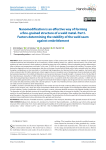
Статья научная
Steel constructions are the most important objects of the construction industry. The main method of connecting individual elements and assemblies of such structures is fusion welding (electric arc, plasma, electron beam). One of the main problems of metal structures is their tendency to brittle fractures that occur suddenly, without noticeable previous deformations, often at below zero temperatures and loads. In this case, 70–80% of such damage is associated with welding. The nature of the destruction depends not only on temperature, but also on the type of crystal lattice. Metals with a body-centered cubic (bcc) lattice (tungsten, molybdenum, α-iron) are plastic at a relatively high temperature, but become brittle when negative. And metals with a face-centered cubic (fcc) lattice (aluminum, nickel, copper and γ-iron) are plastic even at temperatures close to absolute zero. With decreasing temperature, the mobility of dislocations and vacancies decreases, the yield strength σs increases, that is, the ductility of the metal decreases. Using the A.F. Ioffe model showed that the critical temperature of the transition from viscous to brittle fracture with decreasing temperature depends on the rate of increase of σs. In austenitic steels (fcc lattice with a period a = 0.3645 nm), the impurity mobility (paired with a vacancy) through the internode of the lattice is higher, and the growth rate σs is lower than that of low-carbon low alloy steels (bcc lattice with a shorter period a = 0, 2861 nm). Therefore, the low carbon steels from which structures are made are more sensitive to lower temperatures. In addition, resistance to brittle fracture depends on the number and size of metal continuity defects (pores, inclusions, low-plastic phases in the structure, etc.), which are stress concentrators. Welds are the main suppliers of such dangerous defects and sources of crack initiation. During crystallization of the weld pool, a coarse, columnar dendritic structure with reduced ductility is formed. The formation of a fine-grained structure of the weld during crystallization helps to increase its ductility. The grain size in the cast metal (in the weld) depends on the crystal growth rate and the rate of their nucleation. When welding, the most effective way to grind the grain in the seam is to increase the rate of nucleation. The introduction of refractory particles of nanoscale order into the weld pool (nanomodification) allows obtaining a fine-grained weld structure.
Бесплатно
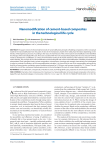
Nanomodification of cement-based composites in the technological life cycle
Статья научная
The paper reviews the theoretical framework of nanomodification principles of building composites and the conceptual model of the nanomodification from the point of view of the evolutionary model of the solid phase formation depending on the kinetics of heterogeneous processes. According to the route, the main factors of the cement system nanomodifcation were identified for all stages of the technological life cycle. These are associated with the nano-sized particles playing the role of a) structure-forming nuclei, b) substrates for crystallization, c) centers of new formation zoning in the matrix substance of the material, d) nano-reinforcing matrix element. The concepts of the nanomodification and technological tools of the nanomodification of building composites are substantiated. Their hydration kinetics, phase composition, microstructure, rheology and strength characteristics are investigated in order to evaluate the efficiency of the nanomodification principles. It is shown that the use of the nanomodifiers enhances the ductility of cement paste, accelerates cement hydration processes by 9–28 times, and increases strength by 1.5–2 times. This will reduce the cost of flow, casting and hardening processes in the technological life cycle of cement-based composites.
Бесплатно
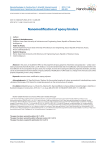
Nanomodification of epoxy binders
Статья научная
In this work, we studied the effect on the properties of epoxy polymers of domestic nanoproduction – carbon nanotubes produced by NanoTechCenter LLC (RF, Tambov). It has been determined that the modification of functionalized CNTs is the most effective in the composition of epoxy resins, for example, in terms of increasing the adhesive properties of binders, and they can be recommended in the formulations of epoxy adhesives. Modification of CNTs leads to a change in the microstructure of the polymer, depending on the curing conditions.
Бесплатно
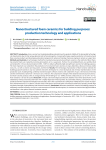
Nanostructured foam ceramics for building purposes: production technology and applications
Статья научная
Introduction. Foam-ceramic heat-insulating building materials have the greatest stability of the demanded technological characteristics due to their unique physical and technical properties. Increasing the large-capacity production of nanostructured foam-ceramic products and developing educational programs for advanced training of process engineers remains an urgent task. Methods and materials. A technological method for manufacturing nanostructured foam ceramics is the method of direct foaming: ceramic foams are created by involving atmospheric air in a suspension. Further, the consolidated foams are carefully dried and sintered for 12 hours by heat treatment (950–1100оC) to obtain sufficiently high-strength foam ceramics for building purposes. The most important raw materials for the production of construction foam ceramics are clays, diatomites, siliceous minerals, zeolite rocks, etc., as well as ceramic and slag waste, and the like. Results. The technology of production of foam-ceramic materials for building purposes based on clay raw materials has been developed. As a result of physical and chemical transformations in the production cycle, including firing, uniformly closed micropores of foam ceramics with a diameter of up to 120 microns are formed, and the wall thickness varies from 1.8 microns to 6.3 microns. The compressive strength of the obtained nanostructured construction foam-ceramic products with an average density of 450–850 kg/m3 is 3–8 MPa, thermal conductivity is 0.12–0.15 W / (m●оC), frost resistance is at least 50 cycles. Discussion. In large-scale technological production, bubbles mass (three-phase foam) can be obtained by mixing nanostructured foam with a highly dispersed mineral powder. By controlled sintering, a dried foam mass is produced with the required technological characteristics due to the crystal bond of a solid-phase mullite based on cluster microparticles with dimensions of 15–200 nm, and the walls of micropores and nodal joints of nanostructured foam ceramics provide high mechanical strength, hydrophobicity and chemical resistance. Conclusions. Nanostructured foam ceramics for building purposes is sufficiently moisture-resistant, since it has a microstructure of closed ultramicropores; it is resistant to chemical and physical effects and therefore is the optimal thermal insulation material.
Бесплатно
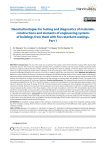
Статья научная
Introduction. The aim of the study was to optimize the quality control of fire retardant coatings (FRC) during their production and use. The results of a comparative analysis of the consequences of fires and their causes with the parameter of fire resistance of objects indicate that the number of fires and damage from them in buildings of the first degree of fire resistance is almost an order of magnitude smaller than in buildings of the second degree of fire resistance. Consequently, increasing the fire resistance of building materials and structures is the way to radically reduce fires and losses from them. Methods and materials. Based on a system analysis of existing fire protection technologies for building materials made of wood, metals, rubber and polymers, nanotechnologies were developed to determine the stability of samples with an FRC on the baro-electro-thermo-acoustic (BETA) analyzer and create their «images» for further diagnosis of their aging at the constructions and operation facility. The novelty of the study is protected by patents of the Russian Federation. Results and discussion. The obtained results consist in the refinement of computational algorithms for the FRC in the BETA analyzer, as well as in the development of a portable automated complex, which allows to determine the stage of «aging» of the FRC on these materials, and, consequently, their durability and update time. This conclusion is based, firstly, on the results of the development of a thermo-electro-dilatometer crucible for controlling liquid and viscous materials by the authors of the «float design», which will make it possible to control the FRC characteristics during their production, and secondly, to carry out express control after filling them in containers (polymer, metal, glass) without opening it and thirdly, due to the recognition of these «images» using thermo-electro-measurements of the FRC using special probes connected to a portable automated system. Conclusion. The results obtained make it possible to «arm» with portable automated systems not only construction and fire control authorities, but also manufacturers of emergency protection products. This will allow, according to the authors, to fundamentally solve the problems of quality and durability of FRC, but the main thing is to guarantee the stability of the protected materials and structures from them.
Бесплатно

Статья научная
Introduction. To determine the effectiveness of fire-retardant coatings (FRC), a system of methods for fire and high-temperature testing of fire-retardant materials and structures made of themis being used. However, there are no methods and means that could provide current effectiveness of fire protection, and existing methods cannot be applied to determine fire resistance of building structures with fire protection, they set only a group of the effectiveness of the flame retardants. Therefore, to assess the quality and durability of the FRC, in case they provide the parameters of thermal stability of the protected materials, structures and elements of the engineering systems of the objects, it was necessary to develop a quickmethod and a portable diagnostic complex of fire-retardant coatings (PDC FRC). Methods, models and tools. Based on a system analysis of the existing fire protection technologies for building materials from wood, metals, rubber and polymers, a rapid analysis methodology and PDC for thermo-electro-acoustic (TEA) sensing of FRCs using thermo-acoustic methods have been developed. That made it possible to determine thermal conductivity, the ultrasound speed and its absorption coefficient in the FRC, as well as to conduct a comparative analysis of the «FRC image» obtained on a BETA-analyzer with measured characteristics, based on which to calculate the time of its operability. Results and discussion. The PDC of FRC consists of a case with a laptop, with the immitance meter and a two-channel oscillographic attachment connected to the laptop, to the inputs of which a TEA-zonding unit is pressed, pressed to the FRC of the tested object (structure, material, cable), by thermal, electrical and acoustic signals from which the laptop software identifies the properties and stages of operational stability of the FRC. The PDC of the FRC and the proposed approach allowed us to synthesize a model of the Internet system of TEA - diagnosis of FRC and of the monitoring of the operational stability of the protected materials. The novelty of the study is protected by patents of the Russian Federation. Conclusion. The proposed approach and the PDC of the FRC made it possible to implement a quickanalysis of the FRC at the facility and to synthesize a model of the Internet system of TEA-diagnostics of FRC, which can become the basis of the national supervision system for the given area.
Бесплатно
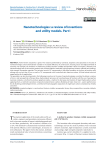
Nanotechnologies: a review of inventions and utility models. Part I
Статья научная
A brief review of patents is given. The research performed by scientists, engineers and specialists in the area of nanotechnologies and nanomaterials resulted in increased efficiency of construction, housing sector and adjacent fields of economy. For example, the invention «А method to produce titanium carbide nanopowder» refers to inorganic chemistry and nanotechnology and can be used to produce wear-resistant abrasive materials, high-temperature ceramic materials and coatings, high-strength composite materials. The technical result is TiC nanopowder in free-filled condition in the form of particles with average size no less than 30 nm, as well as TiC nanopowder with controlled ratio titanium-carbon. All that boosts technical opportunities for its application. The specialists can also be interested in the following inventions in the area of nanotechnologies: a method to obtain a mixture of micro- and nanoparticles of binary alloys, hydrocatalytic processes of recycling heavy oil fractions with the use of perspective nanosize catalysts, a method to produce graphene oxide, a method to decrease electrization of liquid hydrocarbons when applying them, a method to produce composite material boron-carbon, Modeling of static mixer (oil – water) performance for oil desalting and development test, a method of chromatographic separation of single layer carbon nanotubes by chirality and other.
Бесплатно
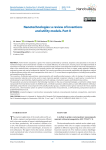
Nanotechnologies: a review of inventions and utility models. Part II
Статья научная
A brief review of patents is given. The research performed by scientists, engineers and specialists in the area of nanotechnologies and nanomaterials resulted in increased efficiency of construction, housing sector and adjacent fields of economy.For example, an invention «A method to produce metal-polymer nanocomposite materials with metal nanoparticles» refers to the method used in production of polymer articles with nanoparticles of silver or copper, widely applied in different engineering areas and used as antibacterial material. The invention provides environmental responsible and reagentless method to obtain polymer articles with metal nanoparticles which size is 5–15 nm and boosts rangeof polymers, including hemicrystalline and amorphous glass-like ones. The invention «Exfoliated polyurethane nanocomposite with polyfluoroalkyl groups» refers to design of composite and nanocomposite materials and can be used to create materials applied in polymer industry, in particularly, in production of solidcoatings for sport facilities, hydroinsulation and roof coatings, construction sealers and tribotechnical articles. The specialists can also be interested in the following inventions in the area of nanotechnologies: a method to obtain metal nanopowder from lead bronze wastes in distilled water, a method to produce collector plates, a water defluoridation method,an exfoliated polyurethane nanocomposite with polyfluoroalkyl groups, amultifunctional grease lubricant for heavy loaded friction joint, a thermostatic system to perform nanocalorimetric measurements, a self-hardening composition based on polydimethylsiloxane et al.
Бесплатно
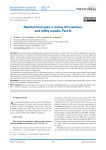
Nanotechnologies: a review of inventions and utility models. Part III
Статья научная
The article provides an abstract review of patents. The results of creative activity of scientists, engineers and specialists, including inventions in the field of nanotechnology and nanomaterials, being implemented, allow achieving a significant effect in construction, housing and community services, and related sectors of the economy. For example, the invention «Raw mixture for production of fine-grained polymer concrete modified by microsilica» refers to construction and can be used in manufacture of nanomodified concretes based on potentially chemically reactive coarse and/or fine filler for transport, industrial and civil construction. Modification of cement stone structures by means of microsilica made of silica production wastes and acrylic dispersion will make it possible to intensify hydration of binder, to reduce cement consumption and to increase strength characteristics of final product compared to traditional concrete mixtures. The invention can be used to produce concrete articles and structures, flagstones, decorative borders, to arrange top layers of road beds and to repair them when it is required, as well as to fill cracks and as a filler in sealing joints. The specialists can also be interested in the following inventions in the area of nanotechnologies: nanomodified high-strength light concrete, combined heat-insulating system, composite layered self-healing material, a method to produce metal/carbon nanocomposites, an electrochemical method to produce nanosized powder of metal silicide, a method to produce metal-polymer nanocomposite materials with metal nanoparticles et al.
Бесплатно
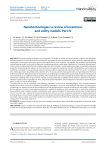
Nanotechnologies: a review of inventions and utility models. Part IV
Статья научная
The article provides an abstract review of patents. The results of creative activity of scientists, engineers and specialists, including inventions in the field of nanotechnology and nanomaterials, being implemented, allow achieving a significant effect in construction, housing and community services, and related sectors of the economy. For example, the invention “Heat-insulating material based on air gel” can be used to obtain heat-insulating materials for a wide range of applications. The required technical result, which consists in improving the thermal insulation properties of the material in a wide temperature range, increasing the absorbing properties of electromagnetic radiation in the IR spectrum, increasing the mechanical strength and flexibility, as well as reducing crumbling, is achieved in an air gel-based material containing a fibrous substrate with a density of 0.001–0.1 g/cm3, consisting of silica and/or glass and/or basalt fibers with a diameter of 0.1–5 microns, which is impregnated with an air gel obtained on the basis of silicon dioxide from alkoxysilane with the introduction of a gelling agent and followed by supercritical drying. The introduction of nanomaterials gives an additional reinforcing effect, which increases the mechanical strength of the final material and significantly reduces the crumbling of the air gel. The final material can be provided with an additional layer of fibrous substrate to increase its vibration resistance. This is especially true when using the proposed material for civil and industrial construction in seismically active zones, as well as in aircraft and rocketry. The specialists can also be interested in the following inventions in the area of nanotechnologies: nano-coating protection method for electrical connectors, preparation method of nanometric size metal oxide additives that reduce the temperature of sintering, raw material mixture for the manufacture of fine-grained polymer concrete (modified with microsilica), installation for the synthesis of carbon-containing nanomaterials, a method for producing silver nanoparticles, a method for producing nanocrystalline cubic tungsten carbide, a composition with carbon nanotubes for obtaining a carbon blank for high-density SiC/C/Si ceramics and a method for producing articles from SiC/C/Si ceramics, composite membrane for drying natural and technological gas mixtures based on graphene oxide intercalated with hydroxylated fullerene derivatives, compositions containing nanometric copper, carbon-ceramic fiber-reinforced composite material and a method for its production, a method for producing nanoparticles of aluminum oxide et al.
Бесплатно
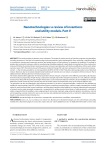
Nanotechnologies: a review of inventions and utility models. Part V
Статья научная
The article provides an abstract review of patents. The results of creative activity of scientists, engineers and specialists, including inventions in the field of nanotechnology and nanomaterials, being implemented, allow achieving a significant effect in construction, housing and community services, and related sectors of the economy. For example, the invention «A method to produce dry construction mixtures» refers to manufacturing of building materials, in particularly, to manufacture of dry construction mixtures (DCM) by the method of joint mechanoactivation of cement and dolomite, with further modification of them with carbon nanostructures (CNT). The technical result of the given method of mixing CNT and main component of dry construction mixtures - cement – is that it makes possible to use microquantities (0.005%) of CNT in DCM. That allows decreasing product cost of obtained mixture. Moreover, due to increased strength, faster hardening of materials one can reduce consumption of these mixtures. That is additional factor affecting decrease of mixture product cost. The results obtained after application of mechanoactivation of basic mixture components were different practically by all indicators from the mixtures prepared by simple mixing. Compression strength and tensile strength increased by 10–15%, adhesion strength increased too. Along with increasing of strength characteristics such an important indicator of DCM as air permeability has decreased. Reduction of total volume of pores in dense structure of cement matrix caused dramatic slow-up of moisture diffusion rate. The specialists can also be interested in the following inventions in the area of nanotechnologies: a method of laser building-up welding for metal coatings, high RAP in WMA surface mixture containing nanoglass fibers, a device to apply nanoparticles of metal oxides on metal surface under normal conditions, multifunctional nanostructured additive for coatings, experimental assessment of cement mortar using nanooxide compounds, a composition for setting constructional layers of road pavements, a method to obtain composite films of nanofibers, nano-engineering of construction materials using molecular dynamics simulations, cast and self-compacting concrete mixture for cast-in-situ concrete and prefabricated reinforced units, a method to obtain photocatalyst based on nanotubular titanium dioxide et al.
Бесплатно
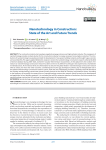
Nanotechnology in Construction: State of the Art and Future Trends
Статья научная
The construction industry has long been regarded asenergy-intensive and high pollution industry. The emergence of nanotechnology provides an ideal solution for the construction industry to energy saving and consumption reduction. The introduction of nanotechnology has greatly promoted the development of new green building materials and brought huge economic and social benefits. This paper applies bibliometric analysis to review the nanotechnology-construction research collected by Web of Science database during 2000–2020, and further visualize their literature characteristics. At the global level, the number of literatures on nanotechnology-construction research has been on the rise in 2000-2019, although it has experienced a small decline in individual years. At the national level, the United States has become the global leader in nanotechnology-construction research with 63 articles, far more than other countries. Considering the income gap, developed countries play an indispensable role in the global nanotechnology-construction research system, while the role of developing countries is relatively weak. We found that the existing nanotechnology-construction research mainly focused on the fields of chemistry and materials science. According to the frequency of keywords, the research focus of nanotechnology-construction research mainly focused on the development and application of new building materials. It is concluded that with the extensive attention of researchers, the future research on nanotechnology-construction will continue to appear and increase at increasing rate.
Бесплатно
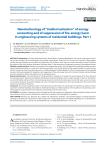
Статья научная
Introduction. Currently, both abroad and in Russia, there is a “general digitalization” not only of certain types of activities, but also of objects of the technosphere, for example, “smart houses”, “safe cities”, etc. However, the “creators” of these objects violated the main principle of automation of Academician V.M. Glushkov, which says: you cannot automate the mess! Therefore, the authors of this article made an attempt to “eliminate clutter” in the automation of engineering systems in the residential sector. Methods, models and tools. Based on the analysis of the engineering systems of multi-apartment residential buildings and individual residential buildings, as a result of the functioning of which not only the delivery of “life support benefits” is carried out, but also fire-energy and environmental damage occurs, a methodology for “intellectualization” of the accounting means for the supplied resources has been developed for diagnostics and suppression of fire and energy harm with the help of modern nanotechnology and, thus, prevention of fires and explosions in the residential sector. Results and discussion. The methodology of “intellectualization” is based on the results of a system analysis of the “functioning of the residential sector” (apartment buildings and individual residential buildings), which made it possible to “discover” the dialectical unity of benefits and harms from consumed energy resources (electricity, domestic gas, hot and cold water), as well as to carry out a systemic synthesis of nanotechnologies and means of “isolation and suppression” of fire and energy harm. The novelty of the research is protected by RF patents. Conclusion. The proposed approach allows “eliminating the disorder before the automation” of engineering systems of multiapartment residential buildings and individual residential buildings, by “intellectualizing” metering devices and optimizing nanotechnologies for suppressing fire and energy harm that brings socio-economic losses.
Бесплатно

Статья научная
Introduction. At present, both abroad and in Russia, accidents, fires and explosions in the engineering systems of multiapartment residential buildings and individual residential buildings have become more frequent. At the same time, the "creators" of automated systems for monitoring and accounting of energy resources (ASKUE) did not attend to the solution of the problems of safety of engineering systems, since their goals were exclusively commercial tasks – "digitalization" of energy consumption metering and detection of illegal consumption of such sources. Therefore, in this article, an attempt is made to "eliminate clutter" in the automation of engineering systems in the residential sector. Methods, models and tools. Based on the analysis of engineering systems of multi-apartment residential buildings and individual residential buildings, as a result of the functioning of which not only the delivery of life support resources (gas, cold and hot water, electricity, communications, etc.) is carried out, but also fire-energy and environmental harm occurs, a methodology has been developed for the "intellectualization" of the means of accounting for the supplied resources, for the purpose of diagnosing and suppressing fire-energy harm using modern nanotechnologies and, thus, preventing accidents, explosions and fires in the residential sector. Results and discussion. The methodology of "intellectualization" is based on the dialectical unity of benefits and harms from consumed energy resources (electricity, domestic gas, hot and cold water), as well as to carry out a systemic synthesis of nanotechnologies and means of "detection and suppression" of fire-energy harm. The novelty of the research is protected by RF patents. Conclusion. The proposed approach makes it possible to "eliminate the disorder before the automation" of engineering systems of multi-apartment residential buildings and individual residential houses, by "intellectualizing" metering devices and optimizing nanotechnologies for suppressing fire-energy harm which leads to socio-economic losses.
Бесплатно
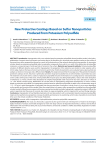
New Protective Coatings Based on Sulfur Nanoparticles Produced from Potassium Polysulfide
Статья научная
Introduction. Impregnation with a new solution based on potassium polysulfide showed excellent results in the hydrophobization of cement stone and cement-sand mortar due to the formation of a nanoscale water-repellent coating on the surface of the pores from sulfur nanoparticles formed as a result of the destruction of the molecule during the drying process. An innovative solution based on potassium polysulfide refers to polysulfur compounds, from which, as a result of the destruction of polysulfide molecules, a nanoscale layer of sulfur particles is formed on the surface. Materials and research methods. Potassium polysulfide solutions of different densities were used for impregnation; the properties of the solutions were tested on cubic samples with a 40 mm edge, made on the basis of cement and cement-sand mortar. Particle characteristics were evaluated using a laser particle size analyzer, an electron microscope and a diffractometer. Results. The analysis showed that the average size of the particles forming the protective coating is 20 nm, they have a spherically symmetric shape and crystallize into an orthorhombic crystal lattice structure. The treatment of concrete with a solution of potassium polysulfide ensures the formation of a coating based on nanosized sulfur on the surface of the pores of the stone, which partially fills the pore space and, being hydrophobic, reduces the water absorption of samples by 2–3 times, and the water absorption of samples impregnated under vacuum for 0.5 hours, decreases to values of 1.3–1.9%. Results and discussion. Modification of concrete with an impregnating composition developed by us with a solution based on potassium polysulfide The impregnating solution based on potassium polysulfide is stable in the concentration range of 1.15–1.35 g/cm3; upon impregnation, it penetrates into the pore structure of concrete at a level of up to 4 cm or more, depending on the growth and structure of the sample. When the material dries in its pores, sulfur nanoparticles crystallize from the polysulfide solution, partially filling the pore space and forming a protective durable insoluble hydrophobic coating that makes it difficult for water to penetrate into the pores of concrete, but retains its vapor permeability, which is important for wall and facing materials. Conclusions. Impregnation of road building materials and concrete products with a composition based on potassium polysulfide improves their performance properties, increases durability and resistance to weathering, which makes it possible to recommend it for use in the climatic conditions of the Russian Federation.
Бесплатно
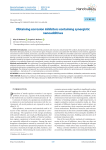
Obtaining corrosion inhibitors containing synergistic nanoadditives
Статья научная
Introduction. Construction materials, products and structures, and primarily their surfaces, during long-term operation have been destroying mainly as a result of two types of impact: corrosive, associated with the influence of an external, aggressive environment on the material, and erosive, caused by mechanical action. An effective and widely used means of protection against corrosion is the use of inhibitors The search for effective methods of anticorrosion protection of metals and alloys is due to the great damage caused by corrosion, not only in technological or economic terms. No less dangerous is the deterioration of the ecological situation caused by the ingress of corrosion products or toxic reagents into the environment. The leading place among corrosion inhibitors is occupied by heterocyclic compounds, namely, nitrogen-containing compounds, in particular imidazoline derivatives. Methods and materials. We synthesized 2-amylidenehydrazinoimidazolinone-4n aminoguanidine, on the basis of which we obtained anticorrosion compositions with the addition of nanoadditives – derivatives of unsymmetrical triazines. Results. The synthesized anticorrosive compositions were tested by electrochemical and gravimetric methods in acidic and model environments. Conclusion. The obtained compounds have a protective ability, and the results indicate the promising use of compositions with nanoadditives – derivatives of 1,2,4-aminotriazines as corrosion inhibitors.
Бесплатно

